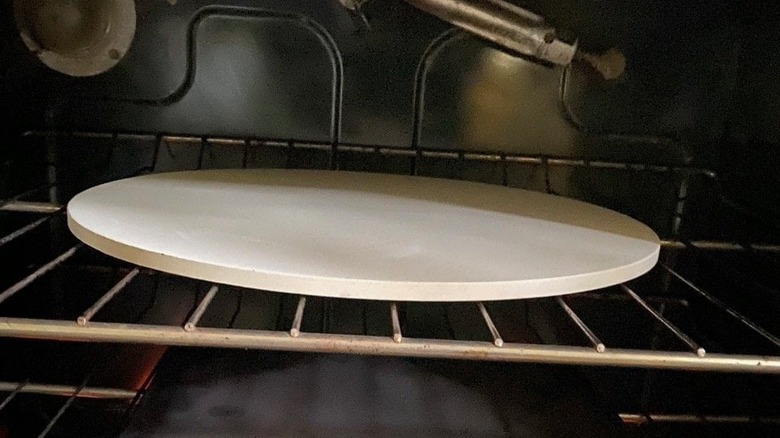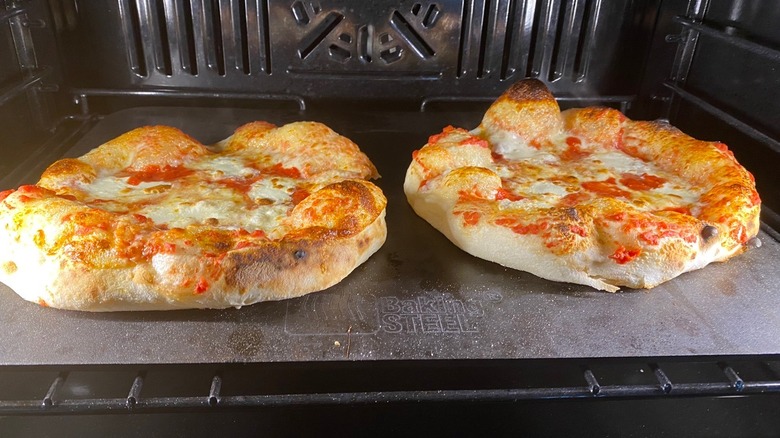What's The Difference Between A Pizza Stone And A Pizza Steel?
There's no experience quite like biting into a warm, cheesy, saucy slice of pizza that just finished baking in the oven.
And it's no secret that Americans especially love their pizzas. In the United States, around 4 billion pizzas are purchased every year, including freshly made and frozen varieties, according to the National Day Calendar. Additionally, pizza restaurants made over $45 billion dollars in sales in 2021 alone, per Statista.
The most traditional way to cook and enjoy pizza is by baking it in a brick pizza oven that reaches extremely high temperatures ranging from 700 to 800 degrees Fahrenheit, but not everyone has access to such hefty equipment and most residential ovens can only heat up to 450 degrees Fahrenheit (via Na Pizza). However, mimicking the taste and look of pizza baked in a brick pizza oven is possible at home with the help of pizza stones and pizza steels.
Pizza stones have been used for a long time, even as early as 11,000 to 47,000 years ago, according to Forno Bravo. Pizza steels, however, are a rather new concept, being introduced commercially in 2012, per Insider.
Both pizza stones and pizza steels serve a similar purpose, but they have a few key differences. Here's what you need to know about them.
Pizza stones
Also called baking stones, pizza stones are made of porous materials including stone, ceramic, and cast iron, and are typically in the shape of a circle, according to MasterClass.
Of course, pizza stones are safe to use in conventional ovens and create a super-crispy pizza crust compared to regular pizza pans and baking sheets. Pizza stones are very efficient at evenly baking pizzas because the moisture from the pizza dough is absorbed into the stone as the pizza bakes, and the materials that pizza stones are made of are great at evenly dispersing heat, per Forno Bravo.
Because pizza stones are made of sturdy materials, they need to be preheated in an oven for 30 minutes, an hour, or a little longer depending on the heating capabilities of individual ovens. Furthermore, putting a pizza stone in a cold oven and letting it warm up gradually before placing the pizza on it helps to avoid any cracks or blemishes from appearing on the stone from thermal shock. While they may take longer to heat up, thicker pizza stones are recommended due to their durability.
Pizza stones should be cleaned by first using a bench scraper or brush to scrub off any remaining food particles, and then a damp cloth can be used to wipe it down (via MasterClass). Tough stains can be removed by using a mixture of water and baking soda.
Pizza steels
As their name implies, pizza steels are made of steel that's nonstick, flat, and smooth, per MasterClass.
Similar to a pizza stone, pizza steels also should be preheated in an oven in order to cook pizzas faster. However, steel is a lot more conductive than stone, so pizzas will have crispier crusts and cook faster when baked on a pizza steel rather than a pizza stone. Furthermore, while pizza stones are susceptible to breaking or cracking from thermal shock, pizza steels are shatter resistant and aren't affected by sudden exposure to high temperatures.
As far as cost goes, pizza steels are more of an investment than pizza stones, so pizza stones are a great option for beginner home chefs or anyone on a budget. However, if you're looking to splurge and can afford it, pizza steels are a great option that will save you time on cooking and may last longer.
Pizza steels can be cleaned using a brush and some water, according to The Pizza Heaven. If your pizza steel is made with anything other than stainless steel, you may have to look out for the formation of rust, which can be removed by using sandpaper and steel wool. Pizza steels should also be seasoned with an oil that has a high smoke point, such as flaxseed oil, grapeseed oil, or soybean oil, after each use to ensure the baking surface stays nonstick for the next use.


